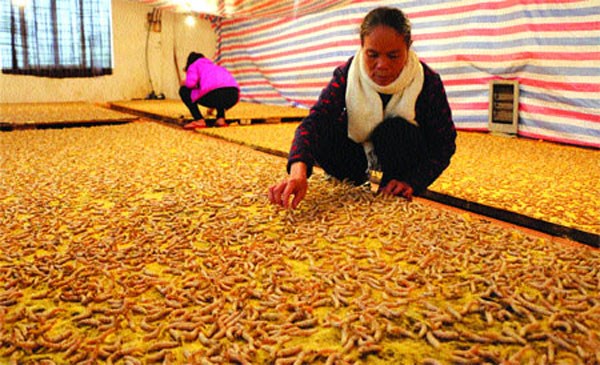Silkworms ‘trained' to weave blankets
 Painstaking process: 65-year-old Thuan checks and swaps silkworms to weave her intricate blankets (Source: VNA)
Painstaking process: 65-year-old Thuan checks and swaps silkworms to weave her intricate blankets (Source: VNA)Hanoi (VNA) - One woman's passion led her to achieve what many others thought would be impossible: training silkworms to weave blankets.
Carefully picking up a silkworm which was crawling out of the order, a woman gently put it back into its right position.
She then walked around a wooden frame, which is about 2m long and 1.8m wide and covered with thousands of silkworms, to check whether all the insects are kept in order or just to replace exhausted with stronger ones.
What she was doing looked quite simple but in fact she was "training" the silkworms to secrete threads of silk to "weave" batting for silk blankets.
The idea to produce silkworm-made batting for blankets, pillows and similar items came to Phan Thi Thuan, from Hanoi's outlying My Duc district, five years ago when the silk production in her village started to dwindle.
The 65-year-old woman said her village in Phung Xa commune in My Duc used to be famous for silk production a hundred years ago but was then at risk of gradually dying because it failed to compete in the market, particularly with Chinese silk fabrics.
Many people in her village decided to quit silkworm raising and went back to rice farming or tried to find other jobs to do.
But Thuan was an exception.
With her strong passion and love for silk, which she started to get involved in since she was a little girl, Thuan was obsessed with the desire to find a more simple and efficient way to keep the traditional craft alive.
"My great grandparents, grandparents and parents all worked in this field and they naturally inspired me since when I was young," she said.
"I cannot remember exactly when I fell in love with it," she said, adding "Seeing the way the worms secrete threads of silk as well as being surrounded by colourful and soft silk attracted a small girl like me to it a lot.”
"As a result, it really hurt me to see the traditional craft dying," Thuan said with a sigh.
After tossing and turning on numerous nights, Thuan determined to find a way to make the craft thrive again.
"Spending days to observe how silkworms make threads to weave their cocoons, one idea flashed through my mind: Why don't we use silkworms to produce our tailored fillings for blankets? How can I make silkworms "weave" a batting instead of secreting the silk to form their cocoons?" she said.
"I spent months carefully watching, following and studying the habits as well as life circles of the silkworms in order to find the most appropriate time to turn the worms into "weavers" to secrete their own silk threads to make batting for blankets," Thuan said.
Then came her endless experiments.
“After nearly a year, I successfully ‘trained' the silkworms to produce silk fibres and spin them into blanket fillings," she said.
"Actually, it is not real training as we thought," she said and smiled. "I just put them together on a ground and create favourable weather conditions for them to make the silk."
To start, suitable silkworms will be put on a wooden frame on flat ground (the size of the frame depends of the size of blankets). It will take the first day for the insects to grope around to make their nests on the ground. In the next days, they start to secrete the silk. Each worm will secrete a single thread of raw silk from 400m to 500m long.
It needs 40kg of silkworms to make one kilogramme of batting.
Instead of secreting silk fibres and spinning them into cocoons, the worms have to let their silk threads fall naturally on the flat surface in the frame, she said.
However, the frame must be put in an area with an environmental condition similar to that inside their cocoons to encourage the worms to secrete the silk, Thuan said.
"The environment must be safe just as in their cocoons. It means that there will be no sunlight, no wind and no loud sound. The silkworms will crawl in disorder immediately if there is sunlight, wind or a sound," she said.
It will take four to five days for worms to secrete all the silk on the frame and make a batting.
The new technique economically proved much better than the traditional methods of weaving silk batting by hand. It made high quality products which were softer and easier to dye and wash, she said.
"The batting made by the silkworms is very soft and durable. A lot of silk threads were piled up solidly and arranged following a fixed distance that only the silkworms could do," she said.
Besides, the new method proves cost effective in the production process. Normally, it will take six people to work on 15 days to complete the whole production process of a silk batting. However, it takes only four to five days for the silkworms to finish their work.
This has significant meaning in creating a competitive edge for Vietnamese silk products in the international market.
Thuan set up a company, called the My Duc Mulberry Silk Company, which specialises in producing silk products of various kinds, such as a silkworm-made blanket, a specialty.
Silkworms-made fillings gained great attention and love from customers, particularly foreign ones.
Her company's products are sold not only in the domestic market but are also exported to many countries such as the United States, Japan, Thailand and the United Kingdom.
Thuan filed a patent application to the National Office of Intellectual Property of Vietnam to register the copyright for her product.
This invention can prove effective in the development of traditional weaving and create a competitive edge for the Vietnamese mulberry silk industry in the international market. It can also bring about great benefits for the silk fashion industry in Vietnam.
Thuan has actively handed down the technique to people in her village as well as people in other craft villages across the country.
Her efforts and determination to develop the silk industry were widely recognised. She was presented with many merits and awards, including the first prize for technical innovation of farmers nationwide earlier this year.-VNA













